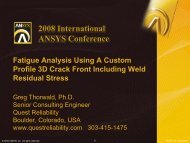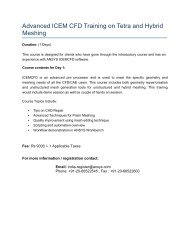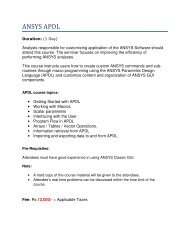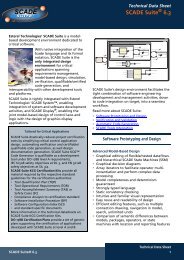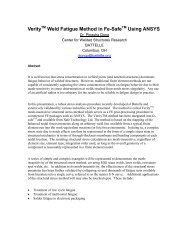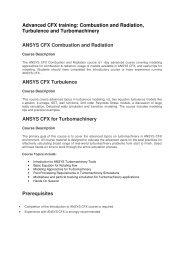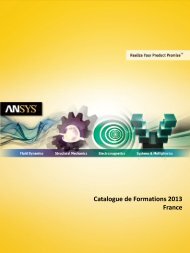Simulation - ANSYS
Simulation - ANSYS
Simulation - ANSYS
Create successful ePaper yourself
Turn your PDF publications into a flip-book with our unique Google optimized e-Paper software.
How are the requirements for simulation in motion<br />
picture animation different than for engineering<br />
simulation involving real-world problems?<br />
The differences are enormous and primarily relate to the<br />
end goal. For motion picture effects, the goal is to create<br />
something that satisfies the visual expectations of the<br />
director. If the fluid behaves inaccurately, or even unphysically,<br />
that is not a problem if it fits within the look and story<br />
of the film. Frequently, the story is about an unusual situation,<br />
so unusual fluid behavior fits with that theme.<br />
How do the fluid physics engines driving animation<br />
software differ from those driving commercial<br />
engineering simulation software?<br />
At the core of the simulation code, the differences<br />
between our simulation algorithms and those in commercial<br />
systems are not that great. We work toward solving the<br />
Navier–Stokes equations through a mix of Eulerian gridded<br />
methods, Lagrangian smooth particle hydrodynamics<br />
methods and some others that are proprietary. The two<br />
codes diverge in the way the simulations are accessed or<br />
driven. Animation artists work in specialized software packages<br />
designed for their specific workflow and have the<br />
ability to create imaginative methods of forcing the fluid and<br />
applying boundary conditions. Also, there are a number of<br />
post-simulation tools available either to alter the simulation<br />
results to enhance or suppress behaviors or to use the simulation<br />
to drive geometry, particles and volumes. We rarely<br />
use raw simulation output in final imagery.<br />
How much time does it take in terms of processing,<br />
person-hours, etc., to produce a challenging fluid<br />
simulation-based animation?<br />
As with all visual effects elements, simulations are set<br />
up, run and revised incrementally over an extended period,<br />
because the goals for the simulation evolve during the<br />
course of the work. For a single iteration, the artist sets up<br />
the simulation conditions (initial fluid state, boundaries,<br />
objects, forcing) and sends multiple versions of the simulation<br />
conditions to the simulation farm, producing three to 20<br />
variations on a simulation per day. Early in development,<br />
setup may take a day to accomplish, but as the work<br />
evolves, setup time is reduced to just a few minutes. By running<br />
multiple simulations simultaneously, the artist can vary<br />
factors such as forcing strength, viscosity,<br />
accuracy, etc., over a short period of<br />
time. The goal is to have a daily<br />
cycle of simulation results, at<br />
least for testing and development.<br />
Late in the development,<br />
www.ansys.com<br />
OUTSIDE THE BOX<br />
the simulations may be run with higher resolution or over<br />
more frames if the scene requires it.<br />
What fluid phenomenon is the hardest to simulate for<br />
visualization in motion picture animation and why?<br />
We have been able to realistically simulate liquids,<br />
gases and fires with our tools. The most difficult problem is<br />
to simulate very large regions of fluid at very high resolution.<br />
Limited computing resources ultimately limit our ability to<br />
simulate big and small scales simultaneously, which is one<br />
of the most difficult problems in fluid dynamics as a whole.<br />
We continue to improve our tools and hardware in order to<br />
simulate greater volume and detail, but we also have<br />
evolving tools for the post-processed enhancement of<br />
simulations. These tools, implemented in a proprietary<br />
scripting language, are based on a combination of physical<br />
reasoning and artistic inspiration.<br />
Can you provide an example of a challenging fluid<br />
simulation from a recent movie?<br />
You might not expect it, but there was a hard simulation<br />
problem in Alvin and the Chipmunks. For a concert scene,<br />
the chipmunks performed near and on top of a cauldron<br />
with dry ice vapors, which had to be simulated using our<br />
CFD system. Since the camera was very close in many<br />
shots, we needed to simulate at high resolution, resulting in<br />
about one week of simulation time. Also, the chipmunks<br />
danced in the vapor, inducing compromises to the simulation<br />
stability. In the end, since the effect was a minor<br />
priority, we simulated at a lower resolution and then<br />
enhanced the simulation output to achieve a nice visual<br />
quality for the final result. ■<br />
Jerry Tessendorf of Rhythm & Hues works on an animation sequence with fluid simulation<br />
for Alvin and the Chipmunks.<br />
<strong>ANSYS</strong> Advantage • Volume II, Issue 2, 2008 53





